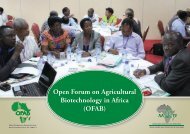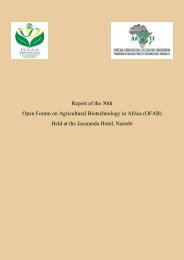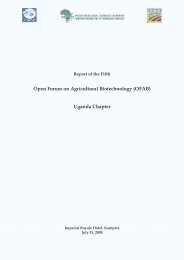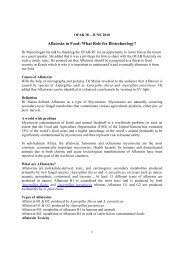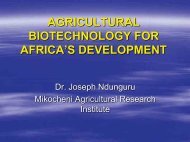Annex 1 List of Participants - OFAB
Annex 1 List of Participants - OFAB
Annex 1 List of Participants - OFAB
You also want an ePaper? Increase the reach of your titles
YUMPU automatically turns print PDFs into web optimized ePapers that Google loves.
Overview<br />
Cowpea (Vigna unguiculata L. Walp) is rich in quality protein and digestible<br />
carbohydrate, has energy content almost equivalent to that <strong>of</strong> cereals grains and an<br />
ideal complement to the protein deficient diets <strong>of</strong> the poor.<br />
It is considered the most important food grain legume in the dry savannas <strong>of</strong> tropical<br />
Africa, where it is grown on more than 12.5 million hectares <strong>of</strong> land. Nearly 200<br />
million people in Africa consume the crop; it provides cash income, is a cheap<br />
protein supplement in human diets and a source <strong>of</strong> quality fodder for livestock.<br />
However, many biotic and abiotic factors greatly reduce cowpea productivity in the<br />
traditional African farming systems.<br />
Efforts are underway to develop improved lines <strong>of</strong> cowpea that withstand biotic and<br />
abiotic stresses, possess greater genetic vigour and contain higher nutritional value.<br />
As part <strong>of</strong> this effort, AATF is coordinating a public/private sector collaborative<br />
partnership project to promote technological interventions that will result in the<br />
improvement <strong>of</strong> cowpea productivity and utilisation in sub-Saharan Africa.<br />
To shed light on the progress that has been made so far, <strong>OFAB</strong> on Friday 23, 2007<br />
invited the lead researcher, Dr. T.J Higgins, to give a presentation on status <strong>of</strong> the<br />
project titled “Partnership for Delivery <strong>of</strong> Insect Resistant Cowpea to Smallholder Farmers<br />
in the sub-Saharan Africa” to the scientific community and other stakeholders in<br />
Kenya.<br />
Opening remarks<br />
Dr. Margaret Karembu, Director, ISAAA AfriCenter and chair,<br />
<strong>OFAB</strong> Programming Committee, opened the meeting by welcoming<br />
all the participants to the second meeting in the year 2007. She gave<br />
highlights on the program, aims <strong>of</strong> <strong>OFAB</strong> meeting and requested<br />
participants to introduce themselves.<br />
Dr. Mpoko Bokanga, Executive director, AATF, thanked the participants for having<br />
spared time from their busy schedules to attend the meeting.<br />
He gave background information, objectives, structure, frequency<br />
and venue for <strong>OFAB</strong> meetings. He said Nairobi had over 39<br />
research institutions thus <strong>of</strong>fering an ideal venue for the meetings.<br />
He thanked Dr. Karembu, for accepting the chair the <strong>OFAB</strong> as part<br />
<strong>of</strong> the collaboration between AATF and ISAAA.<br />
Dr Bokonga said AATF would source for funds to facilitate the<br />
5



